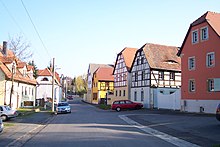Coschütz (Dresden)
|
Coschütz
District of the state capital Dresden
Coordinates: 51 ° 1 ′ 1 ″ N , 13 ° 42 ′ 5 ″ E
|
|
|---|---|
| Height : | 150–260 m above sea level NHN |
| Incorporation : | April 1, 1921 |
| Postal code : | 01189 |
| Area code : | 0351 |
|
Location of the Coschütz district in Dresden
|
|
Coschütz is a district in Dresden . It is about 4 kilometers south of the city center, but still on the southern outskirts at about 225 m above sea level. NHN high.
Together with Gittersee, Coschütz forms the statistical district of Coschütz / Gittersee in the Plauen district .
location
Coschütz is located on the southern slope of the Elbe valley . To the north of Coschütz, the Südvorstadt and Plauen with the campus of the Technical University of Dresden connect on a long and large terrace of the transition to the valley.
To the west of Coschütz is the Plauensche Grund , a deeply cut valley of the Weißeritz . Opposite Coschütz is Dölzschen . Altcoschütz is located on the edge of this valley on a ridge. In the official district, the Coschütz-Gittersee district extends as far as the Weißeritz, i.e. into the Grund.
Gittersee is located south of Coschütz . The town of Freital ( district of Saxon Switzerland-Eastern Ore Mountains ) then connects to the south .
history
Coschütz was first mentioned in 1284. The name goes back to Slavic origins and simply means "village of Kos". What is more astonishing is that the "wicz" ending has not been preserved - as is very common in the Dresden area.
The first settlements were laid out on Heidenschanze as early as the early Bronze Age . Between 6./7. In the 19th century and around 1100 the area was inhabited by the Elbe Slavs.
Mainly used for agriculture due to the good loess soil , the Freital- Döhlener mining area also extends to Coschütz.
The village was laid out in the form of a round and has been preserved in this form to the present day. Altcoschütz is one of a number of village centers in the south and east of Dresden. The oldest surviving buildings go back to the middle of the 19th century. These were built on April 29, 1829 after a major fire in the buildings in the village center. At the end of the 19th century, the farmers sold their land. This marked the beginning of the increasing development on Karlsruhe and Saarstrasse.
Coal deposits were discovered in Coschütz in the 18th century . Two coal pits were built for dismantling around 1780 and the stately Claus coal works in 1836. The coal was transported on today's Kohlenstraße - which is why it got its name - and Karlsruher Straße - which is now also known as Kohlenstraße.
In 1921 Coschütz was incorporated into Dresden.
The Coschütz town hall was built in 1902 and 1903 . In 1946 the Coschützer waterworks was handed over, which supplies about 60 percent of the Dresden population (water hardness 5.8). From 1973, today's Feldschlößchen brewery was built, in which the beer of the Felsenkeller brewery, which was built in Plauenschen Grund in 1857 and closed in 1990 , is also produced. In the south of Coschütz is the Coschütz / Gittersee industrial park , which was created after 1990. On October 27, 2000, construction work began on the Coschützer Tunnel of the Federal Motorway 17 , which was released in this section on July 22, 2005 .
Cultural monuments and important buildings
The Coschützer Wasserwerk was built in 1939 on the site of a former brick factory ; the construction of the pipeline system began as early as 1937. Construction work was delayed until 1946 due to the Second World War . The water is drawn from the Klingenberg and Lehnmühle dams via tunnels and pipes . 60 percent of Dresden's drinking water comes from here.
The town hall on Windbergstrasse was built in 1902 and 1903. At that time Coschütz had around 2,500 inhabitants. A police station and a council cellar were located on the ground floor. Between 1936 and 1945 this was managed by Max Rahm , the discoverer of today's “ Rahm-Hanke ” climbing path below the Bastei rock . Today the building is mainly used as a medical center.
Around 1840 a school building was built on Kleinnaundorfer Straße for the Coschützer and the Gitterseer population, since both places formed a common school community from 1938 onwards. As this had become too small, a new building was built in 1875 and another building in 1907. The facility was used by the 72nd middle school until it was closed in 2005.
traffic
Coschuetz is the Coschützer tunnel by the Federal Highway 17 crosses under. The tram line 3 connects Coschütz with the main station in a few minutes . The stop in Plauen is the closest access to the S-Bahn network . The most important street in Coschütz is Karlsruher Straße, which does not run through the historic village center.
literature
- Coschütz . In: August Schumann : Complete State, Post and Newspaper Lexicon of Saxony. 5th volume. Schumann, Zwickau 1818, p. 85.
- Cornelius Gurlitt : Coschütz. In: Descriptive representation of the older architectural and art monuments of the Kingdom of Saxony. 24. Issue: Amtshauptmannschaft Dresden-Altstadt (Land) . CC Meinhold, Dresden 1904, p. 20.
- Hermann Gretschel: History of the community Coschütz near Dresden. Dresden-Plauen 1904
Web links
- Coschütz at www.dresden-lexikon.de
- Coschütz at www.dresdner-stadtteile.de
- Coschütz in the Digital Historical Directory of Saxony





